 Luke 2.1-7 takes us from the most powerful man in the world to an infant in a cave. That's a pretty stark contrast in a single paragraph. On Sunday, we'll see some of the reasons why Luke tells the story of Christ's birth this way.
Luke 2.1-7 takes us from the most powerful man in the world to an infant in a cave. That's a pretty stark contrast in a single paragraph. On Sunday, we'll see some of the reasons why Luke tells the story of Christ's birth this way.
 This Sunday, we'll look at one event leading up to the birth of Jesus, namely, the birth of John the Baptist. When an angel told Zechariah that he and his wife would have a son in their old age, Zechariah didn't believe it. He was made mute until John was born (Luke 1.5-25). As I studied these stories, I got to thinking, "What do you say after being unable to talk for nine months?" We have the answer to that question in Luke 1.67-79. It's a great model for turning away from unbelief.
This Sunday, we'll look at one event leading up to the birth of Jesus, namely, the birth of John the Baptist. When an angel told Zechariah that he and his wife would have a son in their old age, Zechariah didn't believe it. He was made mute until John was born (Luke 1.5-25). As I studied these stories, I got to thinking, "What do you say after being unable to talk for nine months?" We have the answer to that question in Luke 1.67-79. It's a great model for turning away from unbelief.
Our nation seems more divided than ever on moral and spiritual issues. The different tribes watch comfortable cable channels, subscribe to congenial blogs, or lob incendiary posts at other tribes on social media. Each group is trying to control the script—evangelicals included.
There are fewer places where the tribes even live side by side. A New Yorker might read What’s the Matter with Kansas? while flying over the actual state at 30,000 feet. Here in northern California, it easier for an evangelical to see a video of a scientist on YouTube than to talk with one face-to-face.
But Chico and the ridge have all the tribes. We are not isolated from people who think differently. They’re next door. So, at Chico Grace Brethren, we decided to start a dialogue.
Over the summer we said to friends and neighbors, “If you could ask a pastor to speak on any question, what would it be?” We found that the conversations lowered barriers. We also thought the questions we received were terrific. I choose six of them to address in a short series that starts this Sunday.
The series is called, “Tough Questions,” and the title fits.
Some of the questions are confrontational. “Why would I want organized religion?” Or, “How can Jesus be the only way?” Others come from profound pain. “Why does God allow evil against children?” Two questions are simple requests for information: “What happened when Jesus was young?” “Where is heaven?”
This is a way we can throw away the script and have a real exchange of ideas. I also take written questions about the sermon and answer them during the service. We’ve found that this kind of dialogue keeps the atmosphere respectful and the temperature low. We won’t necessarily be able to agree, but we will find some new ways to talk about timeless issues. We hope you will join us, either at 10:15 a.m. on Sundays, or on the web at chicogracebrethren.com.
by Matthew Raley In 2012, I got a lengthy email from a well-known pastor endorsing Newt Gingrich for the Republican nomination. Gingrich was peaking at that moment and the pastor argued that evangelicals should consolidate behind him. This was the man to deliver victories in the culture wars.
The email was lengthy because the pastor had to navigate rocky moral straights. He said he had wrestled with Gingrich’s adultery and third marriage. How could he endorse a man who had done such things? Several paragraphs of reasoning boiled down to two points. Jesus forgives us all. And Gingrich held the right positions on abortion and gay marriage.
I tapped the little trashcan icon.
That email illustrates an evangelical sexual crisis. We have proclaimed Judeo-Christian morality as the standard for our society, but we are not holding to that standard ourselves. In this crisis, many believers have lost hope for cleansing from their sexual sins. We are caught in what I call the Pharisee’s spiral.
The Pharisees of Jesus’s time reduced spirituality to rules. Keeping the rules made them good. If they broke a rule, there were additional ones that would save them from guilt. For instance, a Pharisee might break an oath that he swore on the temple. But he was still good: since he didn’t swear on the gold of the temple, he was not bound by his oath (Matthew 23:16-17).
The Pharisee’s spiral is the swing between guilt and rationalization. I broke one rule, but I’m safe because I kept another rule. A Pharisee always reads the fine print. That’s where he finds the good news.
The pastor exhibited this spiral when he endorsed Gingrich. Why was Gingrich acceptable now when his moral twin, Bill Clinton, was anathema in the 1990s? They were both adulterers. When Clinton was running for president, evangelicals said that his adulteries were disqualifying. Gingrich lost the House speakership because his own sin was revealed.
Spend time in the Pharisee’s spiral and there’s a neat solution. Both men broke the rule. Both can be forgiven by Jesus. But one has the wrong stance in the culture war, and the other has the right stance. Gingrich is saved by the fine print.
If Gingrich were the only case in which Christian leaders public looped their way through this sort of explanation, the spiritual impact on the average evangelical might not be so devastating. But there have been many leaders like Gingrich. What I hear from believers struggling with their sexual sins is exactly the sort of hurt one expects from people repeatedly cycled through the spiral.
They tell how they got pregnant before they were married. (Broken rule.) Are they safe because they got married and stayed married? (Fine print.) They tell of homosexual experiences. (Broken rule.) Are they safe because they still feel guilty? (Fine print.) They have used pornography. (Broken rule.) Can they be intimate with their spouses without that sin hanging over them? Is there any fine print for that, or are they permanently broken?
Churches are packed with people who need sexual healing, many of whom think sexual purity is a matter of fine print. What they need is genuine good news. Jesus Christ paid not only for forgiveness, but also for a process of cleansing. He paid with his life. And the cleansing he purchased reaches our sexuality, restoring God’s design for human flourishing.
As our society turns the body into a commodity through human trafficking, objectifies women through pornography, eroticizes childhood, and imposes the cost of our sexual decisions on our offspring, we evangelicals cannot satisfy ourselves with declaring absolute standards. We have to declare an absolute Savior. And we can’t declare Him unless we’ve experienced his power.
At Chico Grace Brethren, we’re going to start breaking the Pharisee’s spiral in our own hearts. On March 9th we’ll begin a study of how to stop being “puffed up” in the midst of sexual sin. Our text will be 1 Corinthians 5-6. I will be talking to Christians about the process of cleansing Christ purchased for us. But I invite anyone to listen in on this conversation. More information at chicogracebrethren.com.
by Matthew Raley
 D. A. Carson. A Call to Spiritual Reformation: Priorities from Paul and his Prayers. Grand Rapids: Baker Academic, 2011.
D. A. Carson. A Call to Spiritual Reformation: Priorities from Paul and his Prayers. Grand Rapids: Baker Academic, 2011.
D. A. Carson’s enriching book is more than a manifesto for revival. It is a searching meditation on the imperative, the power, and the generative attitudes of prayer. First published in 1992, the book may be an even more sobering read today, more than twenty years later. The decline of the American church has continued without interruption, and the contributing factors and cultural symptoms of our decline are now worse. Carson’s exegetical depth, however, gives me fresh hope.
Carson opens with an analysis of the American church’s prayerlessness (Introduction), the conclusion of which is that we do not know God well enough. He opens the nature and focus of prayer in a series of chapters drawing on the example of other Christians (Chapter 1), the model of 2 Thessalonians 1 (Chapters 2 and 3), the overall burden for people in Paul’s prayers (Chapters 4-5), and the model of Colossians 1 (Chapter 6). Carson pauses to examine various excuses for prayerlessness and to expound the motivations for overcoming them (Chapters 7-8). He then develops much-needed theological rationales for prayer, dealing with the nature of God (Chapters 9-10), the nature of spiritual power (Chapter 11), and vision for ministry (Chapter 12).
In order to find fault with any of Carson’s exegesis, one would have to marshal detailed technical objections. Even where that might be possible, his devotion to expounding the Scriptures accurately is displayed on every page. Carson’s examination of 2 Thessalonians 1 is rich with applications derived meticulously from context (Chapter 3). On page after page, Carson gives appropriate details about Paul’s inferential and referential particles to clarify why Paul prays and what he prays for. In fact, one of the most edifying features of Carson’s book is his frequent reproduction of lengthy passages that the reader can mull over without any commentary.
Many books are filled with solid exegetical details that nevertheless clutter big themes. Carson’s book is not one of them. He shows the Bible’s big picture of prayer.
In particular, the book corrects the overly individualistic concept of prayer many evangelicals have. Carson doesn’t belabor the inadequacy of a prayer life that is exclusively private, or attack individualism outright. Instead, he shows the communal prayer life of Paul in high definition. And that is rebuke enough. In chapter 4, Carson reproduces prayers from all of Paul’s letters to show how immersed he was in the lives of his fellow believers. Chapter 5 is devoted to an even more detailed treatment of this theme, unpacking 2 Thessalonians 3:9-13. Also, Carson demonstrates that this relational aspect of prayer, taught so exhaustively in the New Testament, was a feature of God’s people more recently. He tells many stories of how the people in his life influenced his praying in chapter 1, and he consistently draws on the history of revivals throughout the book.
This emphasis on human relationships in prayer continues to be neglected, and Carson’s faithfulness to the biblical model remains urgently needed.
There are issues about which I would like to learn more from Carson. For example, he addresses spiritual warfare briefly in chapter 12, which focuses on Romans 15. Prayer in this connection is almost exclusively the preserve of charismatic believers, as it was when Carson first wrote the book. The role of angels and demons in the life of Christ and the growth of the church is a prominent theme of the New Testament. I would like to have seen more about such issues in relation to prayer, especially in light of the mainstreaming of New Age spirituality that has occurred in the last twenty years.
Still, Carson’s book is a powerful antidote to the prayerlessness that has poisoned our spirits.
by Matthew Raley After the North State Symphony's show with Amy Grant in Redding last week, conductor Kyle Pickett button-holed me for a discussion. Grant had sung "El Shaddai" near the end of the show, getting predictably warm-hearted applause. And the predictability was at the core of Kyle's question.
"Is that kind of response real faith in God? Or is it the result of a great performer crafting her show well?"
Kyle wasn't questioning either Grant’s or our audience's sincerity. He was questioning the mixture of entertainment and worship. Good performances and devout worship are both emotionally powerful. But the worshipper’s emotions are supposed to come from a connection with God, not with a performer. Kyle put his finger on a longstanding issue for Protestant evangelicals: when does a skillful performance eclipse God's presence? And when does human passion drown reverence?
He said, "You need to write an article on this." That's my cue.
For Protestants, this issue goes back to the Reformation.
The reformers Martin Luther and John Calvin did away with the distinction between “sacred” and “secular.” They taught that all aspects of life give glory God in Christ--all vocations, all settings, all human endeavor, not just church activities. Colossians 3:17 says, "And whatever you do, in word or deed, do everything in the name of the Lord Jesus, giving thanks to God the Father through him." This principle turns even a Christian's "secular" pursuits into worship. This is why Grant sings "El Shaddai" in the same concert with "Big Yellow Taxi."
But the reformers also taught a high view of corporate worship, fashioning a restrained liturgy to emphasize solemnity in the presence of a holy God. No "Big Yellow Taxi" as an offertory.
J. S. Bach often ran afoul of Pietist Lutherans because these two principles were (and are) in tension. A consummate performer and devout worshipper, Bach had no problem giving virtuosity free rein in church. But the Pietists wanted music kept simple to give free rein, as they saw it, to God.
The evangelicals who make up most of Grant's audience have a solution to this tension. Ditch solemnity. Let the popular passions loose with all their boisterous sentimentality. Amy Grant, church, entertainment, worship--they're all whooping it up at the same gospel party.
As an evangelical, I'm not thrilled with that solution. Entertainment often becomes a flippant substitute for doing business with God. To celebrate new life in Christ without attention to the fact that it came at the cost of his life is presumptuous. Because our sins are destructive to ourselves, others, and God’s glory, Christ's forgiveness calls us to express something deeper than "Woo hoo!" True worship comes from an attitude of submission, while entertainment stops at pleasure.
Still, I did not feel that Grant's "El Shaddai" encouraged flippancy in the audience. She directed the audience’s pleasure to the right source.
First, she was clear about being on stage to entertain. Great performers are able to touch deeper themes without being pretentious or manipulative by being straightforward about their purpose. “I’m here to give you pleasure.”
Second, Grant's three decades as a celebrity have seen plenty of controversy. She has received criticism for both her career and personal decisions. From her perspective of the ups and downs of fame, to sing about one of the Hebrew names of God, who "age to age is still the same," is to make a very personal statement of devotion.
Third, she used the craft of performance to focus attention on the words of the song. A manipulative performer would've pulled out all the stops--the full orchestra, back-up singers, a couple of chromatic modulations--to get the audience on their feet with a longstanding hit. Instead, Grant sang alone, accompanied only by acoustic guitar, communicating with directness and intimacy. This is how performers say, "Remember this one. Walk out with this song on your mind."
Of all the things she could have said at such a moment, she chose to say that God is always faithful to us. It was a great use of performance skill—giving pleasure with truth.
What the audience does with such a moment is another matter. Experiencing Grant's testimony, even identifying with it, is too passive. The glory of Christ calls us to go much further, and entertainment cannot take us there. To worship with integrity, we have to marshal all our skills to spotlight Christ.
To put it more directly, Amy Grant has offered her worship. Where’s ours?
by Matthew Raley Dr. Paul Zingg opened and closed Chico's Community Action Summit with an assertion. At the start of the day, he said that the summit was about "virtues." At the end, he said that he was pleased to hear the issue of wellness receive so much attention. "But," he added, "we must add goodness to wellness."
The distinction goes to the core of the summit's focus: our city's problem with alcohol.
Wellness is good health, both physically and emotionally. As a culture, we are comfortable talking about this category. We spend vast sums of money on fitness, dieting, and medicine. We analyze many problems like alcohol abuse as public health issues. If people were educated about wellness, we think, they would make better decisions.
It's a useful model.
But wellness is not the same as goodness. Goodness is the result of the moral disciplines that Dr. Zingg called virtues. The very term goodness calls us to discriminate between actions -- that is, to discover which ones might be evil. We are less comfortable with this category.
During the summit, the need for clarity about goodness came up repeatedly.
A session on sexual assault was attended by many survivors of violent crimes, both men and women. Several young women identified themselves as survivors of rape, describing an atmosphere on campus in which men laugh about sexual assault, stalking is a constant reality, and the most dangerous spaces are not public but private. One male student described being beaten in front of cheering bystanders. A father told of an attack on his son. Alumni in the group said that the atmosphere has not changed since they were students years ago.
Survivors of actions like these do not need evil explained. They want change for the good.
Assault survivors talked about creating a culture of personal responsibility by focusing on daily actions and relationships. Associated Students president Jay Virdee also raised the issue of personal responsibility and ran a session exploring educational approaches. He is articulate and passionate about this priority, and has ideas to encourage good decision-making through student mentoring.
I attended a session in which bar owners described being swamped with fake driver's licenses, either forged or stolen. They conferred with a police officer, cordially but inconclusively. Does the city have resources to arrest and prosecute the people who make and use fake cards? Clearly not. I was struck by the diligence bar owners and managers have shown in enforcing the laws. They are the people who confiscate fake i.d. from a parent trying to pass his kid off as 21. Personal responsibility came up in this discussion as well.
Clearly we need to change individuals' decision-making. Is wellness a strong enough category to bring about that change?
The parent sneaking liquor into his daughter's dorm room has a sense of wellness. If he thought it would hurt his daughter to drink, he wouldn't get her the stuff. If anything, his sense of wellness is offended by what he sees as intrusive rules.
The 19-year-old who uses his older brother's i.d. to get into bars has a sense of wellness, too. His partying is under control. He gets good grades and holds down a job. He's not on crack. Who gets hurt?
The 26-year-old who gets a 19-year-old woman to "sext" him when she's drunk, and later posts her pictures on the web -- even he has a sense of wellness. How could his actions possibly have hurt her? She's famous now. Guys love her.
On what basis will we argue that these three people are not well? They don't see the harm in their choices. They don't see any connection between their actions and nights of mayhem like last Saturday, when the police received 391 calls in a twelve hour period. These three will say it's other people who are "out of control."
To make the case, we will have to use the word wrong. We will have to talk about what is good. We'll have to examine beliefs -- critically evaluate the reasons we give for our actions. We'll have to speak in terms of goodness because wellness is not a self-evident concept. It is derived from ethics.
There are several things we can do to make this case. We can recover some old words that express the differences between actions: honesty and lying, wisdom and folly, lust and love. We can also restore to educators the mandate to teach these words. Even further, we can link consequences to good and bad actions. These are the things that confident communities do.
As a pastor, my job goes one step further. The gospel I teach has to go beyond wellness. Jesus is indeed a healer. But he did not die and rise again because of our poor decisions. He died and rose again because we are not good. He came to deliver us from evil. Only that message is worth calling "good news."
by Matthew Raley Kyle Wiley Pickett, music director of the North State Symphony (NSS), has built large audiences while programming new music. The NSS has played pieces by regional composers such as CSU Chico's Russell Burnham and Simpson University’s Dan Pinkston, as well as Lowell Lieberman, who is nationally known. On November 10-11, the symphony performed Alban Berg’s Violin Concerto (1935), a classic twelve-tone work, with NSS concertmaster Terrie Baune.
 As a member of the first violin section, I was eager to experience the piece from the inside. I was also interested to gauge audience responses, and to consider what kind of spirituality Berg’s work expresses.
As a member of the first violin section, I was eager to experience the piece from the inside. I was also interested to gauge audience responses, and to consider what kind of spirituality Berg’s work expresses.
In February, 1935, the American violinist Louis Krasner appealed to Berg to produce a work that would show the beauty of twelve-tone music using a concerto form that audiences would readily appreciate.[1] Berg took the commission two months later after the death of 18-year-old Manon Gropius, the daughter of architect Walter Gropius and Alma Mahler, widow of the famous composer. Berg adored the girl, and composed the Concerto in less than four months around the theme of death and loss, inscribing the score, “To the Memory of an Angel.”
The piece rises to Krasner’s challenge in several ways.
It makes dramatic quotations of two tonal melodies, a Carinthian folk song and a chorale by Johann Sebastian Bach. The quotations give reference points for the listener to understand, and to some extent organize, the music he or she hears. They also have strong symbolism, the Carinthian tune conjuring the image of Manon dancing, and the chorale (“It is Enough” from Cantata No. 60) expressing the desire to leave this painful life for the bliss of the next.
The melodies, however, are not mere bones thrown to the audience. Berg assimilates their tonal harmonizations with his twelve-tone row, so that they emerge from his atonal world in a manner that is both musically organic and emotionally devastating. Bach’s tune in particular, with its unusual opening of three whole tones, is an ingenious development of the last pitch classes of Berg’s row.
In this way, Berg brings an audience into his concerto with feats of structural integrity, and his success was affirmed by the warm responses of audiences in Chico and Redding. Terrie earned the ovations not just with technical agility, but with the romantic sensibility she brought to the work. Her sure and beautiful sound production and her astounding intonation gave the performances a confidence that was essential to winning the audiences. She deployed her skills in advocacy of this piece when she might have played a more beloved concerto and garnered even louder applause. Terrie and Kyle are showing our region what it means to have high artistic skill and character.
A serial work has to win over orchestra players before it can reach listeners. Berg’s orchestration is important in this regard.
Even in great tonal works, players often struggle against a composer’s assignment of parts and dynamics, laboring to overcome thick textures or compete with stronger sections of the orchestra. So when a composer orchestrates fluently, the musicians’ work is rewarded. Players simply have to place their notes accurately to realize the composer’s design. They can then spend their time polishing instead of struggling.
Berg is one of these fluent orchestrators, especially considering the technical challenges of twelve-tone music. A basic problem is the equality of each pitch class. Lacking the tonal center of the diatonic scale, which orders seven pitch classes into a strong hierarchy, the row does not allow the listener a sonic home. A serial work’s organization is not even open to players without careful analysis. The main and secondary ideas are actually marked in the scores of serial pieces, so that players will have some understanding of their parts.
From the first bars, Berg’s elegant orchestration clarifies the Concerto’s motifs, structure, and harmony for players and listeners alike. He aligns timbres and overtones in a quintessentially Viennese manner, and also contrasts sections of the orchestra dramatically without drowning the weaker instruments.
This concerto should be recognized as an artistically important marker for modernist spirituality.
Behind the memorial to Manon Gropius lie Berg’s more complicated personal stories. He was a believer in numerology, avidly following the schemes astrological determinism that fascinated many Viennese artists, and encoding secret messages into his compositions.[2] The 10-bar phrase structure of the opening, for example, symbolizes Berg’s mistress Hannah Fuchs. In the concerto’s passages expressing death throes, the violin cries out Berg’s initials along with Hannah’s, filling the Bach chorale that follows with longing for eternal union, not with Christ, but with a lover. The Carinthian song has a double-meaning, recalling a daughter Berg fathered by a family servant as a young man but never knew. Berg lost two young girls.
Berg’s concerto is a mature work of post-Christian culture, a work already nearly 80 years old. In this modernism, the artifacts of Christian hope become malleable symbols, as all cultural artifacts must, expressing the most subjective longings, and consecrating erotic experience as holy ground. Part of what makes this work a classic is its perfect capture of modernist spirituality: the sexual self under the stars.
[1]Kyle Pickett, “Evening at Egan Talk” (unpublished, n.d.).
[2] Douglas Jarman, “Alban Berg, Wilhelm Fliess and the Secret Programme of the Violin Concerto,” The Musical Times 124, no. 1682 (April 1, 1983): 218–223.
Audio for Sunday's sermon
by Matthew Raley One of the visual abstractions we noticed in Alfred Hitchcock's Vertigo was his evocation of famous paintings. We saw that his shot of Madeleine floating in the Bay alludes to the painting of Ophelia by Millais, and that references like this give an unconscious emotional atmosphere to the film.
Bernard Herrmann uses a similar abstraction in Vertigo's score. He refers to musical forms in a way that intensifies the cultural and psychological atmosphere. Two such references are important to the score's role as co-narrator with the camera.
First, Herrmann employs a habanera rhythm in relation to Carlotta. The habanera was a Cuban dance that made its way to Spain in the 19th century, and thence to Europe, becoming famous through Georges Bizet’s Carmen. As a cultural artifact, the dance is associated not just with Hispanic atmosphere but also with seduction.
https://www.youtube.com/watch?v=lspRhX5Vhhg&feature=fvsr
Second, Herrmann uses ecclesiastical forms in his cues at Mission Dolores. He draws the church modes into his harmonies, employing sighing motifs, and using a pipe organ.
Both references, which David Cooper calls “extraopus intertextuality,”[1] remain at some distance from their antecedents. They are not literal. No one dances a real habanera during a café floor show. Scottie doesn’t pass an organist on his way to the graveyard. By remaining abstract, these references allow one’s imagination to play at a less conscious level, and with profoundly ironic implications.
[1] David Cooper, Bernard Herrmann’s Vertigo: A Film Score Handbook, Film Score Guides (Westport CT: Greenwood Press, 2001), 65.
by Matthew Raley
 I've given several examples of Alfred Hitchcock's abstract visuals in Vertigo (here and here). But Hitchcock also created a sound-world to match, and he found a collaborator in Bernard Herrmann. Together, they raised the score to the level of co-narrator with the camera.
I've given several examples of Alfred Hitchcock's abstract visuals in Vertigo (here and here). But Hitchcock also created a sound-world to match, and he found a collaborator in Bernard Herrmann. Together, they raised the score to the level of co-narrator with the camera.
The term “Wagnerian” is often used to characterize Herrmann’s score for Vertigo, and for good reason. But the variety of composers who influenced Herrmann hints at a more complex musical imagination.
He was famous for loving English composers such as Edward Elgar[1] and Ralph Vaughan Williams.[2] Vertigo’s frequent similarity to music by Claude Debussy is mentioned by critics.[3] Less well-known is Herrmann’s study as a thirteen-year-old of Hector Berlioz’s Treatise on Orchestration. The influence this Romantic maverick had on Herrmann was life-long.[4] Nor was Berlioz the only musical outsider with whom Herrmann identified. Though Herrmann spent his student years in New York close to such American icons as Aaron Copland and George Gershwin, Herrmann also developed relationships with young radical composers in a group modeled on Les Six.
Most significantly, Steven Smith documents Herrmann’s long association with Charles Ives, the ultimate outsider, noting Herrmann’s early study of Ives’s 114 Songs and his habitual visits with Ives until Ives died in 1954.[5]
With such a background, there should be no surprise that Herrmann’s score is one of the more abstract elements of Vertigo.
It is not explicitly tonal—that is, the harmonies are not organized around a triad that specifies a key, but around the pitch-class structures and intervallic relationships that occur in the first bars of the prelude. Such harmonies, while not expressionistic, are at the outer reaches of the common practice era.
Herrmann, further, employs a modular phrase structure that permits the extension of a line, but is not intrinsically melodic, alluding to but not identical with the traditional eight- or sixteen-bar phrase.

As we will explore over the next posts, the abstraction of Vertigo’s music allows it to operate with subtlety, concision, and force. The score is a large part of the greatness of this film.
[1]Bernard Herrmann, “Elgar: A Constant Source of Joy,” in Edward Johnson, Bernard Herrmann: Hollywood’s Music-Dramatist, Bibliographical Series 6 (Rickmansworth: Triad Press, 1977), 29–31.
[2]Bernard Herrmann, “Vaughan Williams’s London Symphony,” The Musical Times 100, no. 1391 (1959): 24.
[3]William H. Rosar, “Bernard Herrmann: The Beethoven of Film Music?,” The Journal of Film Music 1, no. 2 (2003): 137; Royal S. Brown, “Herrmann, Hitchcock, and the Music of the Irrational,” Cinema Journal 21, no. 2 (April 1, 1982): 20.
[4]Steven C. Smith, A Heart at Fire’s Center: The Life and Music of Bernard Herrmann (Berkeley: University of California Press, 2002), 14–15.
[5]Ibid., 21–23, 38–39.
by Matthew Raley The name "Jesus" has been a blank screen in America for a long time. If I embrace the name, I acknowledge that "Jesus" is the epitome of goodness. But, in a neat trick, I can project onto the name whatever righteous shape I hold dear.
Evangelicals, among whom I count myself, are some of the most skilled projectionists, and many people are now wary of our "Jesus."
We evangelicals are quick to deplore the progressive "Jesus" who thought up socialism before there was even a proletariat, or the Buddhist "Jesus" who did a semester in India. We rejected the self-doubting "Jesus" of "Godspell," "Jesus Christ Superstar," and "The Last Temptation of Christ," molded to match faddish ideals of personal authenticity. More recently, we've inveighed against the gnostic "Jesus" who had a child with Mary Magdalene -- a savior for conspiracy theorists.
Our culture only accepts gods it has re-imagined in its own image. We're right to dismiss all these Jesus-projections. But we can't seem to reject the blank screen itself. We've profited too heavily from it. If we were to set the bar at intellectual honesty, we'd undermine our salesmanship.
For the last forty years at least the evangelical "Jesus" has looked as close to the American consumer as possible. Consider the Jesus-projection you are most likely to watch in an evangelical church.
In appearance, he is an Anglo-German woodsman with great hair. In attitude, he's way non-threatening. In manner, he uses open gestures. He doesn't lecture or argue. He uses sports analogies when talking to men and tear-jerking stories with women. He says, "Dude!"
This "Jesus" can be narrated like a sitcom in 18 minutes (minus commercials). Each week, the live studio audience laughs at the right times, but there comes a moment when they feel really bad for "Jesus," maybe shed a tear. They realize how nice "Jesus" is to us, and how mean we are to him, and this hushed epiphany motivates them to try harder at being positive.
The Jesus of the New Testament is nothing like this.
The real Jesus is ancient. He cannot be understood, much less received, without a basic knowledge of his culture and history, and that is why pastors used to think of themselves as teachers. Many Christians see that Jesus is not the Now Guy evangelicals project, and the good news for them is that he can still be known. We know him through the ancient method by which our minds labor in the Bible's words and in prayer, interacting with the real one who rose from the dead.
Furthermore, the real Jesus had a message about the outworking of history. He did not give inspirational chats about living positively, like some huckster from Houston. The classic distillation of his teaching is, "Repent, for the kingdom of heaven is at hand." God is driving events toward his goals, and those events can sweep an individual away no matter how positively she thinks. That word repent is almost illegal in churches today, probably because it contains the one message contemporary people can't abide: "God's plan isn't all about you."
But there is more good news for the people who already know this. Though the projection of the hyper-compassionate woodsman who is on call for you 24/7 is bowlderized, there is still the real Jesus. He is our Sovereign, whose power has swept us into his plan. The injustice and violence of our world will dissolve in the heat of his stare, and the new city we hope for will be built.
Ultimately, the real Jesus defied those in his own time who wanted to use him as a blank screen. Many people followed Jesus, John reports, but had agendas for him to fulfill. Jesus "did not entrust himself to them." (John 2.24) When many wanted him to overthrow the Romans, for example, "Jesus withdrew again to the mountain by himself." (John 6.15)
So there is still more good news. In the swirl of efforts to re-imagine Jesus after our likeness, the real Savior has a mind of his own. And he's still commanding, "Follow me."
by Matthew Raley Abstraction in art is any step away from a thing-in-itself. Artists use abstraction to open emotional and reflective space in their work -- space that isn't there at the literal level. As I wrote in my last post, there is a range of abstraction levels in every work of art, and Hitchcock's Vertigo is especially full of examples.
I've shown several examples of how Hitchcock took steps away from concrete referents like characters inside the film and even artworks outside of it. Here are some instances of higher visual abstraction, in which the referents are less concrete.

A quite high level of abstraction is the reference of the film back upon itself. This is not merely the foreshadowing of an event early and the event’s later completion, but the recurrence of entire sequences of action, like the pursuits that end with Scottie witnessing a fatal plunge. Deborah Linderman, for example, acknowledging her dependence on Raymond Bellour, reads Vertigo as “a series of self-reflecting mirrors,” describing a displacement of stasis that recurs all the way to the final shot.[1] Peter Wollen uses similar terms to describe the plot.[2]
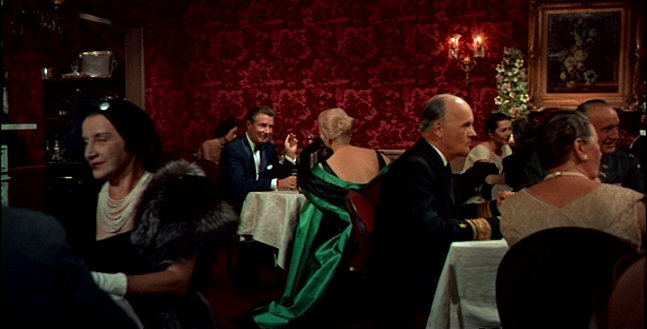
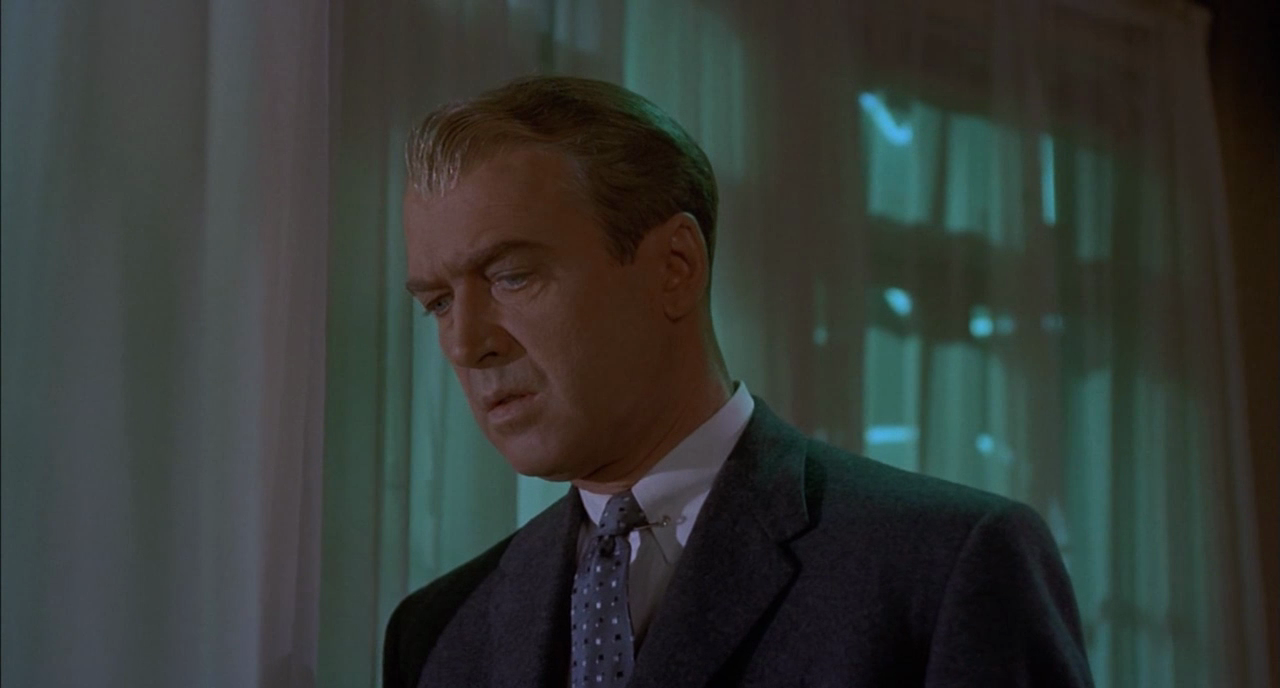 The motif of red and green that permeates the film does not represent a literal thing in the story; the colors influence the emotional atmosphere while maintaining visual coherence. The drab greens and reds in the hallway leading to Judy’s hotel room can be seedy, while the red and green theme at Ernie’s can communicate opulence. The artificially limited palette retains a broad range of impacts.
The motif of red and green that permeates the film does not represent a literal thing in the story; the colors influence the emotional atmosphere while maintaining visual coherence. The drab greens and reds in the hallway leading to Judy’s hotel room can be seedy, while the red and green theme at Ernie’s can communicate opulence. The artificially limited palette retains a broad range of impacts.
 Another example of this level of abstraction would be the famous spiral motif in the opening titles. Spiral references occur in Scottie’s nightmare, in the mission tower staircase, and even in Madeleine’s hair. While the spiral does represent the physical condition of vertigo, in a sense, there is no suggestion that the condition actually looks like a spiral, either to the onlooker or to the sufferer. On the contrary, the literal imitation of vertigo is Hitchcock’s famous point-of-view shot in which the camera zooms in and tracks back at the same time.
Another example of this level of abstraction would be the famous spiral motif in the opening titles. Spiral references occur in Scottie’s nightmare, in the mission tower staircase, and even in Madeleine’s hair. While the spiral does represent the physical condition of vertigo, in a sense, there is no suggestion that the condition actually looks like a spiral, either to the onlooker or to the sufferer. On the contrary, the literal imitation of vertigo is Hitchcock’s famous point-of-view shot in which the camera zooms in and tracks back at the same time.
Again, each level of reference raises the significance of the story’s literal elements, enabling us to reflect on the story, explore the internal structure, and discover larger meanings. The film is not just about a dizzy cop. The spiral helps us connect vertigo with erotic obsession. The mise-en-scène prompts us to question the characters’ relationships and motives more deeply. A simple filter can lift an image out of the prosaic and invite a second look, a thinking look.
[1]Deborah Linderman, “The Mise-en-Abîme in Hitchcock’s ‘Vertigo’,” Cinema Journal 30, no. 4 (July 1, 1991): 52.
[2]Peter Wollen, “Compulsion - Does Vertigo, Hitchcock’s Most Personal and Perverse Thriller, Show Him as a Surrealist?,” Sight and Sound. 7, no. 4 (1997): 14.
by Matthew Raley To start exploring why Vertigo has been called one of the greatest films of all time, let's look at Alfred Hitchcock's use of abstraction. The word abstract is used freely to describe artworks, but the meaning of the word can be difficult to specify.
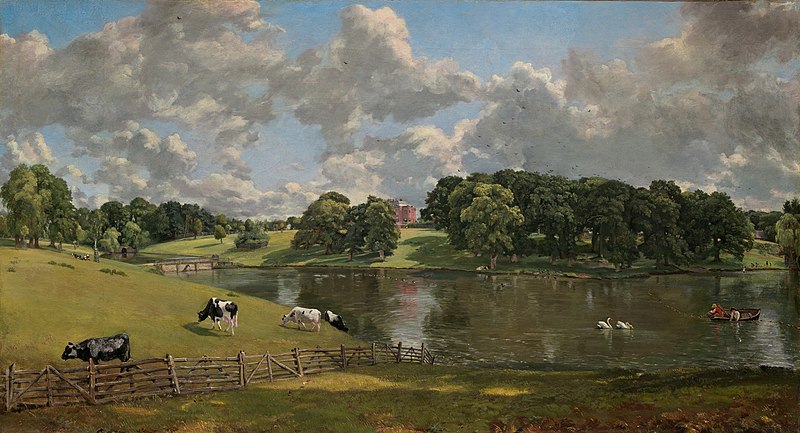

Abstraction in art is usually contrasted with representation, the use of forms rather than the use of imitation, as if these were absolute categories. This antithesis is easy enough to maintain if the artworks are Piet Mondrian’s Composition II in Red, Blue, and Yellow (1930) and John Constable’s Wivenhoe Park (1816). But I wonder whether antithesis is the best way to analyze abstraction in a work. Is there no abstraction in a painting if it contains recognizable eyes, ears, or fingers?
Clearly not. Artworks have many levels of abstraction in them, from low to high.
I define abstraction as any step away from a referent, from things-in-themselves to representations, imitations, or evocations of those things. An artist may intend such a reference to be close or distant, obvious or subtle, and the artist uses this range of interaction with things to control a work’s atmosphere, meaning, and relationship to its audience.
Hitchcock is a master at employing many levels of visual abstraction, and Vertigo is filled with examples.
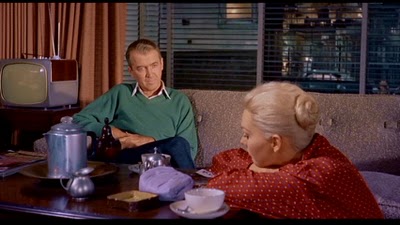
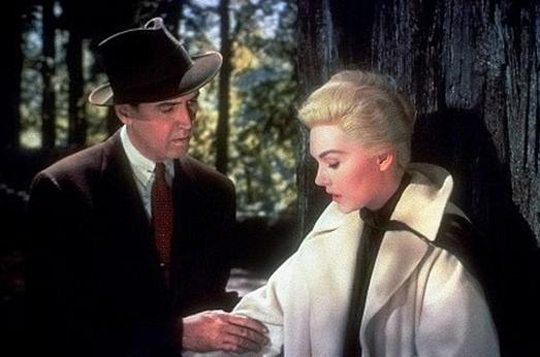
Take two low levels of abstraction. The first, so low as to be routine, would be the camera’s literal capture of James Stewart and Kim Novak not representing themselves but Scottie and Madeleine. A slightly higher level would be the representation of Stewart and Novak in the Redwoods using a filter, which lends a dream-like quality that is less representational of the literal scene.
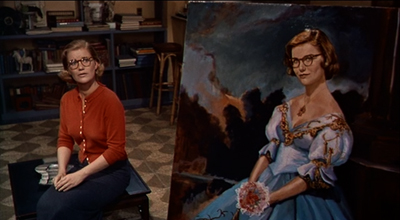
Hitchcock’s layered mise-en-scène throughout Vertigo would be a higher level of abstraction yet, informing plot development and characterization through placement within the frame. The point of view shot in which Scottie sees Midge’s parody of the Carlotta portrait next to Midge herself in the same pose is only one instance, a double juxtaposition of the fantastic with the normal.


Mise-en-scène, in a still higher level of abstraction, can refer to iconic images from other art sources. One critic, for example, argues that Hitchcock’s portrayal of Madeleine in the bay refers to the Pre-Raphaelite Ophelia (1852) by John Everett Millais.[1]
So a reason for Vertigo's greatness is the richness of Hitchcock's visual language. He crafts frames with varying degrees of abstraction, creating an emotional resonance with the viewer.
We'll see more examples of this next week.
[1]James M. Vest, “Reflections of Ophelia (And of ‘Hamlet’) in Alfred Hitchcock’s ‘Vertigo’,” The Journal of the Midwest Modern Language Association 22, no. 1 (April 1, 1989): 1-9.
by Matthew Raley Interpreting art has always been a problem. Can a painting have a theme? When does a novelist cross the line between portraying wrong actions and endorsing them? Can you be morally or spiritually corrupted by listening to a song?
These questions are more emotional when they involve cinema, partly because of its sheer popularity over the last 80 years, partly because of the visceral power of the medium itself. Christians want to engage films spiritually, but they get tripped up by the moral quandaries they find.
These are important issues, but they make a poor starting-point for a spiritual discussion of film -- or of any art. Before we dive into Alfred Hitchcock's Vertigo, I want to explain why I will address the moral and spiritual issues last.
It is a rare work that has both greatness and a "message." Great artworks focus questions pointedly and show experiences palpably. They do not provide many answers. By contrast, works that convey a message are not usually art, but propaganda. Before we can approach the issues raised by films, then, we have to think in a more filmic way.
In evangelical entertainment today, sadly, there is almost no art. The expectation of both producers and consumers is that "Christian" books, music, and films will have a "good message," and the message itself removes the works from consideration as serious art. Evangelicals rush to give answers almost as a matter of principle. If they thought more carefully about art, they might see the value of provoking the right questions.
There is a more specific problem for Christians who want to engage "secular" films.

For pastors, using a film as a sermon illustration has become a popular way to make a point, with certain films like The Matrix (1999) or The Lord of the Rings trilogy (2001, 2002, 2003) attracting almost permanent enthusiasm. The retelling of films as spirituality tales is a branding device for some authors.[1] Medieval allegorizing is even recommended by some academics as a hermeneutic for engaging film spiritually.[2]
Such uses of film seem less like dialogue than monologue. Not every self-sacrificing character is a Jesus figure.
Vertigo has incited a great deal of moral discussion, but has been especially open to agenda-driven interpretation.
One of the most influential concepts of feminist film theory, Laura Mulvey’s idea of the “male gaze,” was formulated using Vertigo as an illustration.[3] Mulvey famously psychoanalyzed the film in terms of Freudian scopophilia. It has also been read as an allegory of existential psychology,[4] and an opportunity for theological study of human motivations.[5] More whimsically, critics have used it as a point of comparison with Shakespearean characters,[6] and even as a metaphor for Kim Novak’s entire film career.[7]
Vertigo starts to look like an inkblot test.
There are ways to address the spiritual issues raised by this film that go beyond the brain candy of allegorizing, or reading the film in terms of a favorite construct. We can embrace the complexity of what Hitchcock created, and we can let the rich layers of meaning guide us to the issues.
But we have to do good work first.
[1]John Eldredge, Wild at Heart: Discovering the Secret of a Man’s Soul (Nashville: Thomas Nelson, 2005).
[2]Robert K. Johnston, “Transformative Viewing: Penetrating the Story’s Surface,” in Reframing Theology and Film: New Focus for an Emerging Discipline, ed. Robert K. Johnston (Grand Rapids: Baker Academic, 2007), 304-321.
[3]Laura Mulvey, “Visual Pleasure and Narrative Cinema,” Screen 16, no. 3 (1975): 6-18.
[4]Kirk Schneider, “Hitchcock’s Vertigo: An Existential View of Spirituality,” Journal of Humanistic Psychology 33, no. 2 (1993): 91-100.
[5]Neil P. Hurley, “Mutability of Motivation: Hitchcock’s Films,” Theology Today 35, no. 3 (O 1978): 326-328.
[6]Wendy Lesser, “Hitchcock and Shakespeare,” The Threepenny Review, no. 11 (October 1, 1982): 17-19.
[7]Vincent L. Barnett, “Dualling for Judy: The Concept of the Double in the Films of Kim Novak,” Film History 19, no. 1 (January 1, 2007): 86-101.

